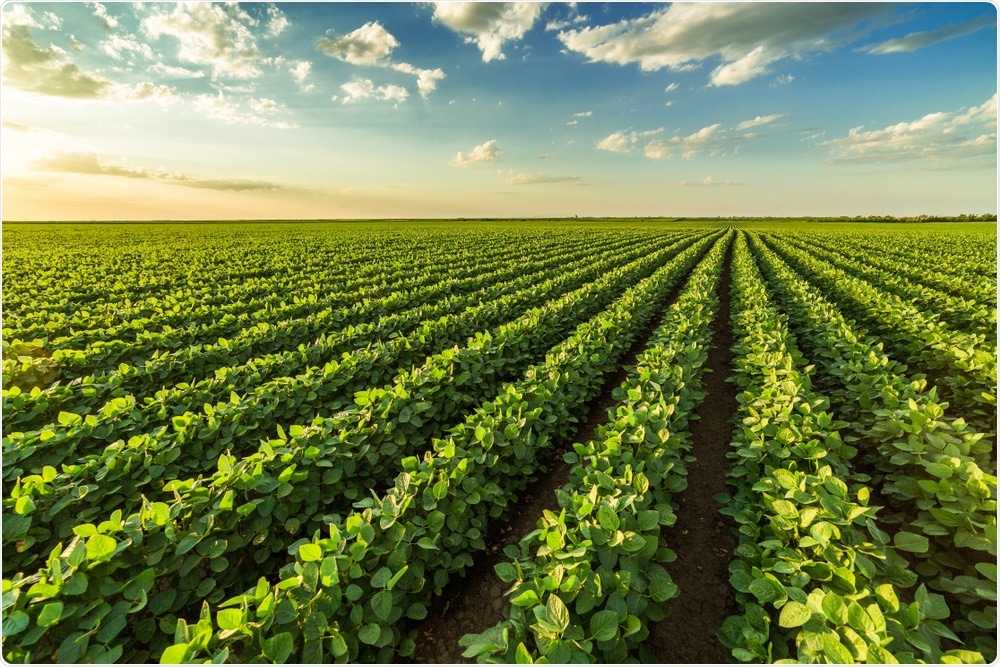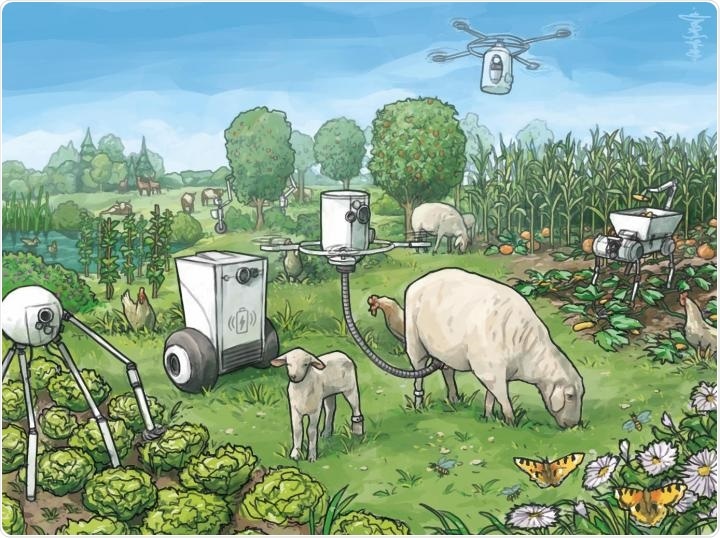In this interview, we spoke to agricultural economist Dr. Thomas Daum about farm robots and their potential within the field of agriculture.
Please could you introduce yourself and tell us what inspired your career into agriculture?
I am an agricultural economist. I choose to pursue an agricultural career because agriculture is so fundamental to address many of the challenges of humankind: hunger, hidden hunger, poverty, healthy diets, climate change, and biodiversity, among others.
If managed well, agriculture can contribute to the solution of all of the problems.

Agriculture. Image Credit: oticki/Shutterstock.com
What agricultural methods are currently used to conserve biodiversity and combat climate change? Can you describe some of the limitations of these methods?
There are two sets of methods, which follow different paradigms: intensification and agro-ecology. Proponents of intensification want to use modern inputs and biotechnology to ensure high yields on existing farmland so that much land can be left untouched. This contributes to conserving biodiversity and addressing climate change because land-use changes, for example, from converting rainforests and savannah, are the biggest threat to biodiversity and the largest agricultural source of CO2.
At the same time, such types of farming are often disastrous for biodiversity at the local level. They are typically associated with simplified farm landscapes with rectangular fields of monocultures and there are problems with agrochemicals affecting environmental health.
Proponents of agroecological farming denounce the use of such inputs and instead focus on agronomic practices, for example, around soil fertility and pests/disease management. Such type of farming is typically more sustainable at the local level, however, often associated with lower yields. Hence more land is needed to feed the world population. Robots could help us reconcile the two paradigms by ensuring high yields and the protection of local biodiversity.
What are ‘farm robots’ and how could they benefit the environment?
Farm robots are autonomous machines controlled by artificial intelligence (AI). There are different degrees of robotization. Some farm robots are stationary and fulfill a predetermined task, without the need for much AI. Milking robots are an example. Others are mobile and characterized by higher levels of AI.
There is much consensus that autonomous types of equipment and farm robots can help us to use farm inputs more efficiently, for example, by applying fertilizer more precisely and replacing herbicides with more surgical mechanical hand hoes or lasers, hence benefit the environment. But farm robots hold an even bigger, more disruptive promise as they could help us to fundamentally change our farming systems.
You have described that there are two possible extremes for the future of agriculture, a utopia and a dystopia. Please could you tell us more about these two extremes and their advantages and limitations?
In the utopia, we have swarms of small robots enabling a very diverse, agroecological type of farming with multiple crops, vegetables and fruits, and livestock. The robots enable a return to mosaic-type field structures with trees, hedges, and small streams. Few, perhaps no, agrochemicals are needed. Such types of farming systems would harmonize with local biodiversity and make farming more resilient to climate change. It’s a Garden of Eden type of farming. Many elements of the utopia are already possible today but simply not feasible with large tractors and they are very labor-intensive. As such, they are often associated with lower yields, hence larger land demands.
The yields in organic farming are significantly lower for example. In the utopia, these downsides are solved thanks to robots. But the utopia is not guaranteed. In the dystopia, since robots may work best in structured and controlled environments, everything is very monotone - some would talk about agrarian or biodiversity deserts – farming and nature are strictly separated. The dystopia is likely to be high-yielding but would be a missed opportunity for environmental protection.
Is either of these extremes more feasible in large-scale farms which are predominately seen in the US and Brazil?
On large-scale farms in the USA or Russia, the pure utopia with swarms of small robots will be more difficult to achieve. However, with the rights policies and as farmers realize the need to adapt to climate change, large robots – or a mix of large and small robots - may gradually be used to practice many elements from the utopia such as mechanical weeding with surgical hoes or lasers, strip multi-cropping, the integration of trees and hedgerows, among others. Hence we would get closer to the utopia as well.
We may also decide to split up large plots to have more small plots of land again (which may still be owned by large farmers). These large plots are often the result of tractorization and the need to save labor but the economic rationale for this will change.
What guidelines need to be in place to help ensure a utopian environment for the future?
First, we need to be aware that such a future is possible and agree that it is something we should aim for as a society. Then we can set the institutional frame conditions to achieve the utopia. From a technological perspective, the utopia will be more challenging, hence we may not end up there automatically. In the dystopia, robots can remain relatively “dull”, everything is designed around them and greatly simplified.
The utopia hinges on robots that can cope with the complexities of unstructured and diverse farm environments. This requires big-data analytics, machine learning, and artificial intelligence, and experts with combined expertise in engineering, agronomy, and ecology. We can channel research funds towards such forms of robotization and teach such experts.
Moreover, technological trajectories can be shaped by complementary policies such as regulations, subsidies, and taxes to reflect the true costs of different agricultural practices, and by consumer decisions.

Utopian farm robot scenario. Image Credit: Natalis Lorenz
How would these two extremes also affect consumers?
Today’s farming systems are good to produce cheap calories but nutrients are mostly expensive. The utopia, which produces cereals but also vegetables and fruits, among others, may help to change the relative prices of both, leading to more healthy diets. The food from the utopia, which comes from healthy soils and requires no agrochemicals, may also be slightly safer and healthier; however, research comparing conventional and organic food suggests that these effects are minimal.
Importantly, agriculture not only provides food but also has many functions. The utopia is aesthetically much more appealing, hence provides more recreational value. Lastly, without dramatically reducing the environmental footprints from agriculture, we will not meet the climate change targets and stop biodiversity loss. If we fail to address these issues, this will affect all of us.
Do you believe that if more funding is made available to farmers and action is made now, we would be able to achieve the utopia?
Achieving the utopia will be more challenging from a technological perspective but it is very much possible to realize. It’s a unique potential. Like few other technologies, farm robots hold the key to reconcile agricultural production with biodiversity by helping to reduce the yield penalties and labor requirements associated with agroecological farming.
What are the next steps in your research?
I am conducting several studies on Farming 4.0 and smallholder farming in low- and middle-income countries, in particular in Africa and South Asia. Farming 4.0 plays out very differently here but still comes with many new opportunities and challenges.
I research how to harness the potentials while minimizing the risks and make sure Farming 4.0 is inclusive and sustainable.
Where can readers find more information?
About Dr. Thomas Daum
Dr. Thomas Daum is a researcher at the Institute of Agricultural Science in the Tropics (Hans-Ruthenberg-Institute). His work focuses on finding solutions for sustainable agricultural development, in particular in Africa and Asia. His areas of interest include agricultural mechanization and digital agriculture, among others.
He has been honored with several prestigious awards, including the Josef G. Knoll - European Science Award 2020 and the Landmark in the Land of Ideas Award 2018 by the German Federal Government. Dr. Daum has been working with several international organizations including the World Bank and the German development agency (GIZ).
He is working as a freelance journalist for the Frankfurter Allgemeine Zeitung and the Süddeutsche Zeitung, among others, and is part of the editorial board of “Welternährung”, a journal of the German “Welthungerhilfe”.